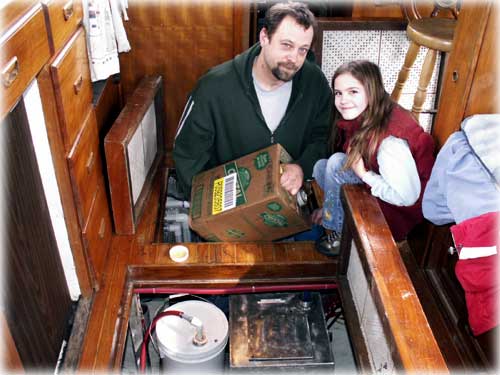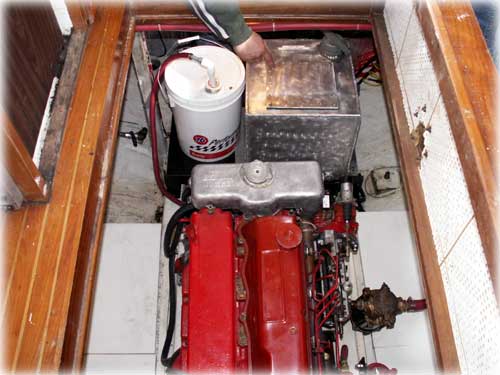 Fill'er Up With Waste Vegetable
Oil
Fill'er Up With Waste Vegetable
Oil
By Marie L. Monyak
May 09, 2006
Tuesday AM
Ketchikan, Alaska - Fuel Prices on the Rise ~ Petroleum Production
Tax ~ Hybrid Cars ~ Drilling in ANWR ~ Exxon's CEO's $400 Million
Retirement Package ~ Biodiesel ~ Energy Crisis ~ Fuel Shortage
~ and on and on. Fuels, primarily fossil fuels and all related
topics are the fodder for countless headlines in recent weeks.
Americans are raging and they want answers and solutions.
The ordinary citizen depends on big business, politicians, scientists
and researchers to find solutions and answers to their everyday
problems yet throughout history it's been the common man, the
average person, that's come to the aid of their fellow man. When
a person has a need that can't be fulfilled they see it as a
problem but when historic figures like DaVinci, Jefferson, Franklin,
Edison and Bell had a need, they perceived it as a challenge.
 John Holstrom pouring
Waste Vegetable Oil in fuel tank of the M/V Hadar.
John Holstrom pouring
Waste Vegetable Oil in fuel tank of the M/V Hadar.
Photograph by Marie L. Monyak ©2006
One man in Ketchikan, Alaska has that same drive to find a solution
for today's most talked about problem; the high cost of fuel
and the reported shortages. He has successfully converted a City
of Ketchikan municipal vehicle and his own personal motor vessel
to operate on 100% vegetable oil. Not Biodiesel, not Ethanol,
just plain waste vegetable oil that is generated daily by millions
of restaurants.
Meet John Marshal Holstrom of Ketchikan; 40 years old, divorced,
father of two teenagers, fisherman and boat owner who is employed
by the City of Ketchikan Public Works Department as a Mechanic.
One day Holstrom had a conversation with a coworker about the
high cost of home heating fuel and the use of alternative fuels.
That conversation led Holstrom's coworkers, Dennis Spurgeon and
Bob Sivertsen, to order a conversion kit they had read about,
a kit that would enable early model diesel engines to utilize
vegetable oil as a fuel source.
The kit arrived in October of 2005, a very busy time for the
Public Works department so it was put on the back burner so to
speak. In March of this year, Holstrom read an article in the
Anchorage Daily News that said the City of Anchorage was interested
in creating a pilot program to convert city vehicles to burn
Biodiesel as a main fuel source. The article spurred Holstrom
to action knowing that the City of Ketchikan didn't need a pilot
program, they already had the conversion kit sitting on a shelf,
albeit a little dusty.
There's one major difference between what Anchorage and Ketchikan
are doing. Anchorage is discussing the use of Biodiesel, a blend
of diesel and used cooking oil, generally a 90/10 or 80/20 mix,
whereas the conversion Holstrom is using calls for 100% used
cooking oil.
Last month Holstrom and his coworkers successfully completed
the conversion in one week on a City of Ketchikan, 1996 Ford
F-800 Landfill Recycle Drop-box Vehicle. Holstrom explained that
the reason it took a week was because he had to fabricate the
tank mount and various parts. Speaking excitedly, Holstrom said,
"The first thing we did was get the truck to operating temperature
while it was sitting in the garage. As usual, we could smell
the diesel fumes and feel the irritation in our eyes. Once the
engine was warm we flipped the switch to vegetable oil and the
smell of diesel dissipated and all we could smell was french
fries!" That's right, french fries! Keep in mind that they
were using waste vegetable oil (WVO) from local restaurants.
It should be explained that because vegetable oil tends to congeal
at colder temperatures it must be warmed. The vehicle must be
started first on diesel until the WVO has warmed sufficiently
to flow freely, then with the flick of a switch the engine begins
burning the WVO held in an auxiliary tank.
Holstrom was first to drive the converted truck to pick up Sivertsen
across town at the City Landfill where the two traded places
allowing Sivertsen to determine for himself if he felt any difference
in power, which he did not. Holstrom reported that the vehicle
has 5 hours operating time on WVO to date and has shown no apparent
problems. "I think we may be the first Municipal vehicle
in the State of Alaska burning WVO," Holstrom stated with
pride.
Enthused by his first success, Holstrom had the idea to attempt
the conversion in a marine application. Owner of the M/V Hadar,
a 1975, 34 foot CHB Tri-Cabin Cruiser with a 120 Lehman Ford
diesel engine, he set to work designing his own conversion with
the help of his 17 year old son. It took the entire month of
April to complete the design and fabricate the necessary parts
and finally, by the end of the month, the kit was successfully
installed and running smoothly.
 The temporary day tank
that holds Holstrom's WVO and the marine vessel conversion kit
of his own design.
The temporary day tank
that holds Holstrom's WVO and the marine vessel conversion kit
of his own design.
Photograph by Marie L. Monyak ©2006
Before Sunday, May 7th, Holstrom only had 4 hours run time on
his boat engine using WVO and on that day, this writer along
with Holstrom's friends and family went for the inaugural boat
ride. There was no discernable difference in burning WVO, no
spitting, sputtering, hesitation or stalling. Shortly before
returning to dock, Holstrom made the required switch back to
diesel. Once again, because the WVO may congeal at low temperatures,
diesel must be run through the engine and fuel pump before shutting
down thereby priming the engine for the next start up. The switch
was smooth and unremarkable.
Although not a scientific test, the run was an outstanding success
and the trip around Pennock Island was an enjoyable one. At one
point during the trip, Holstrom's friend Mary noticed a bottle
of Crisco oil next to the stove in the cabin and to everyone's
amusement said, "Hey, if we ever run out of fuel we have
Crisco! That's our spare bottle." Since it's already filtered,
straight unused vegetable oil can also be used if waste oil is
unavailable.
The group couldn't help but speculate on the ramifications of
this new fuel source such as the obvious benefits to the environment
by using a non-polluting fuel source. In Alaska, where restaurants
are not required to utilize grease traps, WVO regularly clogs
sewer systems causing countless man hours to be spent on maintenance.
In Ketchikan, many restaurants cooperate with the city by taking
their used grease to the landfill who must then pay to ship the
used grease out of state and the cost is passed on to the consumer
in the form of higher landfill fees. And what of the agriculture
industry, could it become the fuel supplier of the future? Would
farmers increase their crops of corn and soybeans to produce
more vegetable oil? Questions came and went as fast as the wind
yet everyone on board agreed that as with anything new, the public
would have to wholly embrace the concept of vegetable oil as
a viable alternative fuel before any real consequences would
be noticed.
Holstrom still has more work to do before his project is complete
and meets his standards of perfection. He explained, "I'm
using my day tank to hold the WVO but I plan on installing a
100 gallon main tank so I can conveniently take on fuel from
outside the boat". He's keeping track of his run time so
he can estimate his gallons per hour on WVO and also keeping
records of any maintenance he performs so he can one day record
a scheduled maintenance program for the new system. The biggest
hurdle Holstrom will have to cross will be to design the conversion
kit for newer diesel engines that have fuel injectors and electronic
fuel management controls. In the meantime his next goal is to
convert a Hitachi EX-200 Track Excavator.
With the price of Diesel advertised at $3.13 a gallon at Safeway
Gas in Ketchikan and rumors of the price climbing to $4 a gallon
by summer who wouldn't want to fill up their truck or boat with
used vegetable oil that's free from restaurants willing to give
it away? Who wouldn't prefer the smell of french fries and popcorn
over diesel exhaust? While pondering these questions consider
this; at the World's Fair in the late 19th century, one of Rudolph
Diesel's original diesel engines was designed to run on peanut
oil!
So what would be the biggest drawback to using WVO to power diesel
engines? Why, the smell of course! You can't help but have a
craving for fried food!
For information and questions,
contact John Holstrom at: got-oil-john
[at] hotmail.com
Related Story:
What's cooking in place of gasoline by Dick Kauffman - Something's cooking
in place of gasoline for Joseph Prows' Chevy greese car! Prows
is just one of a small growing network of drivers who are responding
to environmental concerns, rising gas prices and dependence on
foreign oil by finding ways to steer clear of gas pumps. - More...
July 11, 2005
Marie L. Monyak is
a freelance writer living in Ketchikan, Alaska.
A freelance writer is an uncommitted independent writer
from whom a publisher, such as SitNews, can order articles/photographs
for a fee.
Republication fees
are required for articles and/or photographs. Contact Marie at
mlmx1[at]hotmail.com
for costs and republication permission.
All Rights Reserved. ©2006
Publish A Letter
on SitNews
Read Letters/Opinions
Contact the Editor
SitNews
Stories In The News
Ketchikan, Alaska
|


